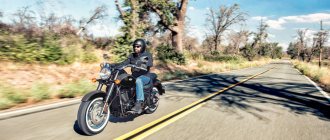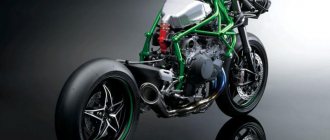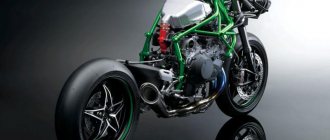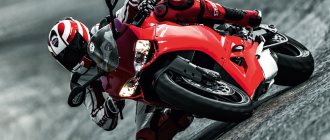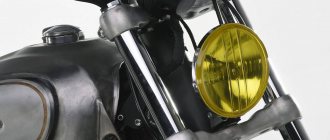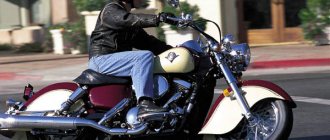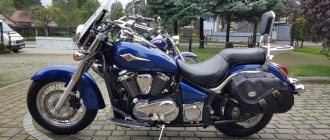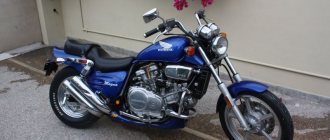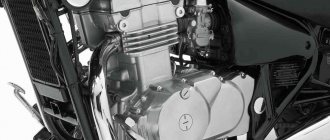Stylish, powerful, comfortable... These are not all the epithets that can be applied to the two thousandth Vulcan from the legendary Kawasaki. The Kawasaki VN 2000 Vulcan is a serious machine with a lot of potential, but it handles like a classic cruiser. This is the main idea of the designers.
The aggressive, but at the same time discreet design of the Kawasaki VN 2000 Vulcan is in harmony with the corresponding filling. All components of the motorcycle are designed to make it a real beast. Of course, with power comes a high degree of control.
Specifications
In terms of its parameters, the Kawasaki VN 2000 Vulcan is almost ideal.
This is explained by the concern’s extensive developments in the field of motorcycles in general and cruisers in particular.
Engine
The motor of the motorcycle is very powerful. This is not some accident. The concern planned to create a model with a very powerful engine, while maintaining the handling of an ordinary cruiser. Well, they succeeded, and from 2004 to 2010 the world could enjoy a magnificent motorcycle of unprecedented power.
Four-stroke and two-cylinder, this V-twin engine has a displacement of a whopping 2053 cubic centimeters. It is clear that the creators also took care of the proper capacity of the gas tank: it is 21 liters. Fuel consumption is only 5.65 liters per 100 kilometers. This is truly a motorcycle for traveling!
At 3200 rpm, peak torque reaches 177 Newton meters. Power at its maximum is 103 horsepower at 4800 rpm. These are serious indicators that speak volumes about the performance of the motorcycle.
The engine is liquid cooled and feels great even when working hard at the limits. According to the type of ignition, the model is transistor, and the fuel supply system is implemented using an injector.
Kawasaki Vulcan
05.01.2017
Since 1984, the harsh name Vulcan ]Kawasaki[/anchor] has denoted many models of choppers, customs and cruisers, mainly built on V-twin engines with a displacement from 125 to 2000 cm3. Also in the model name, as a rule, the designation VN
– for example
Kawasaki Vulcan VN 1700
.
History of Kawasaki Vulcan models:
1984-2006: Vulcan 750
1984 Kawasaki Vulcan 750
Kawasaki VN750
, also known as
the Vulcan 750
, is Kawasaki's first cruiser with a V-twin engine.
The motorcycle had a cardan drive to the rear wheel. In addition, a modification was produced VZ750
, distinguished by chrome wings and a number of other minor features.
For the US market, until 1986, due to a number of restrictions on Japanese motorcycles that were in force at that time, a modification was made with the engine displacement reduced to 699 cm3. The design of the Kawasaki Vulcan 750
, with the exception of paint schemes, remained virtually unchanged for 22 years.
VN750's
power was 66 hp and torque was 64 Nm. The motorcycle weighing 219 kg accelerated to 180 km/h.
1986-2004: Vulcan 400
1986 Kawasaki Vulcan EN 400
First Vulcan
- “four hundred” appeared in 1986 and was positioned as an entry-level cruiser.
the Vulcan 400
inline-two engine had a displacement of 398 cm3, liquid cooling, a 6-speed gearbox and a belt drive to the rear wheel.
The Vulcan 400 with an in-line cylinder arrangement had the index EN400
.
1995 Kawasaki Vulcan VN400
The second generation Vulcan 400 received a V-shaped twin with a volume of 399 cm3, index VN400
and a design similar to the 750 cc model. The gearbox has become five-speed, and the drive has become chain. Produced in Classic and Drifter versions.
1990-2009: Vulcan 500
Kawasaki VN500 Vulcan 2003 model year
Kawasaki Vulcan VN 500
– a cruiser with a parallel twin of 498 cm3, also used on the Kawasaki Ninja 500R.
Sold under the name EN500
.
1987-2008: Vulcan 1500
Kawasaki Vulcan 1500
– one of the most popular and massive Volcanoes in the entire history of the model. It was produced in the form of several modifications, differing in design elements and individual technical solutions.
Kawasaki Vulcan VN1500 Classic 2004 model year
VN 1500 Classic
– the basic model of a cruiser, with a V-twin with a volume of 1470 cm3 of liquid cooling and a cardan drive to the wheel.
The motorcycle had a saddle 700 mm high, a wide handlebar and forward footpegs. The Vulcan VN1500 Classic Tourer
featured alloy wheels, a wider front wheel, a different exhaust system, a larger adjustable windshield, side panniers and plenty of chrome trim.
The VN 1500 Drifter
was the first of the large Vulcans to receive electronic fuel injection. The design of the Drifter model clearly showed the features of the legendary Indianas of the 40s. As standard, the motorcycle was equipped with only one large driver's saddle.
Kawasaki Vulcan VN1500 Mean Streak 2001 model year
VN 1500 Mean Streak
– Vulcan with an understated teardrop design, a kind of low-rider or power-cruiser, close in style to models such as HD Night Rod, Honda VTX, Suzuki Boulevard M109R (aka VZR 1800) and Yamaha Star Warrior.
The VN 1500 Nomad
is a touring cruiser equipped with a windshield and panniers.
The power of the Kawasaki Vulcan VN 1500
varied from 64 to 72 hp. depending on the modification and year of manufacture. From 1989 to 1999, a modification of the Vulcan 88 engine was produced with a displacement of 88 cubic inches or 1464 cm3.
1995-2006: Vulcan 800
Kawasaki VN800 Classic 2003 model year
Kawasaki Vulcan VN800A
appeared in 1995 and became the first Kawasaki cruiser made in a modern style.
It featured a softail frame, a 21” front wheel and a cropped rear fender. The second model - VN800B (Classic)
was produced since 1996 and had a more classic retro style with full-length fenders and 16-inch wheels both front and rear.
Kawasaki VN800 Drifter 1999 model year
Vulcan 800 Drifter version
was a variant stylized as the Indian Chief of the 40s.
Engine VN800: Two-cylinder V-shaped, displacement 805 cm3, liquid cooling. Gearbox: 5 gears. Rear wheel drive: chain.
2002-2009: Vulcan 1600
Kawasaki Vulcan 1600 Classic
Produced in three versions: Kawasaki Vulcan 1600 Classic
– a model with a traditional classic design, without any non-standard frills.
Kawasaki Vulcan 1600 Nomad
Kawasaki Vulcan 1600 Nomad
– a touring model with a large windshield, a passenger seat with a backrest and panniers.
The Kawasaki Vulcan 1600 Mean Streak
is a power cruiser that replaced the 1500 Mean Streak. Also produced under the Suzuki brand was the VZ 1600 Marauder model (later, from 2005, the Boulevard M95). The differences between these twins from Kawasaki and Suzuki were the different design of a number of parts - headlights, fenders, side air filter covers and dashboard design.
2004-2010: Vulcan 2000
Kawasaki Vulcan 2000
Kawasaki Vulcan 2000 Classic LT
The two-liter Vulcan was produced in two versions - Classic and Classic LT. The LT featured side bags, a windshield, passenger footwells, and a passenger backrest. Thus, the Vulcan 2000 Classic LT was more suitable for long-distance tourist voyages. Until 2006, the Vulcan 2000 could be easily recognized by its special elongated headlight design, which was replaced by a more traditional design on later versions. The Vulcan VN2000 engine had a displacement of 2053 cm3 and a power of 116 hp. and an outstanding torque of 191Nm. The rear wheel drive is belt driven.
Current Kawasaki Vulcan models: VN 900, VN1700 and Vulcan S
2014 Kawasaki Vulcan 900 Custom
From 2006 to the present, the “junior” Vulcan model is the Kawasaki Vulcan VN900
.
Powerplant: Liquid-cooled 903cc V-Twin with belt drive to the rear wheel is shared across three trims: Classic, Classic LT and Custom.
LT (Light Tourer) – the same Classic, additionally equipped with a passenger backrest, side bags and decorative trim. The Custom version features a 180mm wide rear wheel, a narrow 21" front wheel, a lower saddle and drag-style handlebars.
Kawasaki Vulcan VN1700
appeared in 2009. The family includes the following modifications:
Kawasaki Vulcan 1700 Classic 2014 model year
VN1700 Classic
– basic model. Cruiser of classic design.
2014 Kawasaki Vulcan 1700 Classic LT
VN1700 Classic LT
(Light Tourer), differs from Classic in windshield and leather side bags
Kawasaki Vulcan 1700 Nomad 2014 model year
VN 1700 Nomad
, has a windshield, a passenger backrest and hard side cases with a capacity of 76 liters. Electronic cruise control.
Kawasaki Vulcan 1700 Voyager 2014 model year
VN1700 Voyager
, a cruiser that is not afraid of the longest distances. Wide fairing with additional headlights, high windshield and multifunctional instrument panel, side cases, rear case with a wide passenger backrest. The total volume of luggage compartments is 126 liters. Electronic cruise control.
Kawasaki Vulcan 1700 Voyager Custom 2014 model year
VN1700 Voyager Custom –
a cruiser in the recently popular “bagger” style. A massive front fairing with a short “symbolic” windshield, luxurious instrumentation and audio system, side cases, an extended exhaust system. Electronic cruise control.
The engine in all VN1700 is a V-twin with a displacement of 1700 cm3, liquid cooling, and a power of 74 hp. and a torque of 135 Nm. Six-speed gearbox and belt drive to the rear wheel. Power supply system with electronic throttle control. K-ACT ABS system with enhanced coordinated braking technology, designed specifically for heavy motorcycles.
2015 Kawasaki Vulcan S
Kawasaki Vulcan S
– the latest model, which will hit the markets in 2015.
A unique combination of modern technology and classic cruiser style. 649 cc inline twin-cylinder engine, chain drive to the rear wheel, narrow body, low weight and long wheelbase. Ideal for beginners or those who need an everyday city motorcycle. – official Kawasaki dealer in the Russian Federation. From us you can buy a Kawasaki Vulcan motorcycle and other models of this Japanese brand. All motorcycles undergo proper pre-sale preparation, and during further operation, our motorcycle services perform any warranty and maintenance work on motorcycles, installation of additional equipment, accessories, tuning and repairs of any complexity. Return
Dimensions and weight
Curb weight is 371 kilograms. This is a serious indicator that turns the motorcycle into a real heavyweight. However, the remaining dimensions correspond to this mass, making the motorcycle simply huge and suitable only for people of at least average height.
The saddle height is not very high and reaches 680 millimeters. The height of the motorcycle itself is 1155 millimeters, which is quite high. The width of the bike is 1025 millimeters, which is not surprising given its enormous size. The wheelbase is 1735 millimeters.
The length of VN 2000 Vulcan reaches a huge size: 2535 millimeters. This makes it similar to other giants in the class, including the 1700 Vulcan. However, it is quite simple to operate, which is a considerable merit of the concern’s designers, who realized what they wanted.
This cruiser was a great choice for intermediate drivers who had owned cruisers before. The fact is that other giant motorcycles are not so easy to control, which makes them suitable only for experienced professionals who are familiar with such equipment first-hand.
Technical characteristics of the Kawasaki VN2000 motorcycle (2007)
| Engine | ||
| Type | 4-stroke, two-cylinder, V-shaped | |
| Working volume, cm3 | 2053 | |
| Cylinder diameter and piston stroke, mm | 103 x 123.2 | |
| Compression ratio | 9,5:1 | |
| Valve mechanism | OHV (overhead valves), 8 valves | |
| Fuel system | electronic fuel injection (EFI), Keihin throttle bodies 2 x 46 mm | |
| Starter | electric | |
| Ignition | digital | |
| Lubrication system | forced, oil pump | |
| Engine oil | Class | API SE, SF, SG, SH (JASO MA) or SJ (JASO MA) |
| Viscosity | SAE 10W40 | |
| Engine power | ||
| Maximum power, kW (hp) | 76 (103) / 4800 rpm | |
| Maximum torque, Nm | 177 at 3200 rpm | |
| Transmission | ||
| Transmission | 5-speed | |
| main gear | belt | |
| Main gear ratio | 1,500 (48/20) | |
| Gear ratios | First | 2,550 (51/20) |
| Second | 1,630 (44/27) | |
| Third | 1,219 (39/32) | |
| Fourth | 0,939 (31/33) | |
| Fifth | 0,730 (27/37) | |
| Final gear ratio | 2,445 (48/44 x 72/32) | |
| Clutch | multi-disc in oil bath | |
| Frame, suspension | ||
| Frame | duplex, high-strength steel | |
| Fork tilt, degrees | 32° | |
| Fork offset, mm | 182 | |
| Front suspension | 49mm telescopic fork | |
| Rear suspension | pendulum, with 8 levels of adjustment | |
| Suspension travel, mm | front | 150 |
| back | 100 | |
| Tires | front | 150/80R16M/C (71V) |
| back | 200/60R16M/C (79V) | |
| Brakes | ||
| Front (pistons) | double, disc (300 mm) - 4 pistons | |
| Rear (pistons) | single disc (320 mm) - 2 pistons | |
| Dimensions | ||
| Length, mm | 2535 | |
| Width, mm | 1025 | |
| Height, mm | 1155 | |
| Wheelbase, mm | 1735 | |
| Ground clearance, mm | 135 | |
| Seat height, mm | 680 | |
| Dry weight, kg | 340 | |
| Tank volume, l | 21 | |
Chassis and brakes
The motorcycle wheels will please connoisseurs of alloy wheels, while at the same time, fans of spoked wheels will not be too disappointed, because Kawasaki has maintained a certain balance and made the alloy wheels somewhat similar in appearance to the spoked ones.
The front brake of the VN 2000 consists of two discs, each with a diameter of 300 millimeters. They are accompanied by a four-piston caliper. The rear brakes are a 320mm disc with a two-piston caliper.
The frame of the motorcycle is steel and has a tubular outline. The pleasant design fully corresponds to the dimensions of the model: it is not wasted on small details, on the contrary, it is all solid and respectable, as befits such a bike. All elements of the body are monumental and represent a solid, majestic image.
The rear pendulum suspension has a shock absorber. Its stroke is 100 millimeters. The front suspension is a telescopic fork with dimensions of 49 millimeters. This fork has a travel of 150 millimeters.
The handlebars of the motorcycle are quite large, which is not surprising, since the bike itself is one of the largest in the world. The steering mechanism is also what makes this steel monster so easy to maneuver compared to other bikes of its size. In addition, the steering wheel is very comfortable, which also improves handling.
Review of the Kawasaki VN 2000 Vulcan motorcycle
It is HEAVY, HUGE and pushing it “cancer” up the hill, foolishly parking it with its wheel in a curb (or curb ) on the slope, and without dropping it, is a feat worthy of Atlanteans... But, damn it!!! How convenient it is!!!
) on the slope, and without dropping it, is a feat worthy of Atlanteans... But, damn it!!! How convenient it is!!!
This motorcycle doesn’t just go, but actually GOES, responding to the slightest movement of the gas river. At the same time, the speed is not felt at all, just the speedometer needle suddenly appears at 80 miles... And this motorcycle BRAKES (but learn to use all the brakes given to you by nature, gentlemen!).
The soft and deep sound of the standard exhaust has more than enough volume, impressiveness and pressure to “blow away” interference from the aisle, without “taking out the moss” of the plus one and without forcing, after the trip, to heart-rendingly yell “Hello??!!” when they ask you something  .
.
Perhaps most fully, this motorcycle is characterized by the phrase “a motorcycle with big eggs” (which, by the way, are pretty much fried in traffic jams with a two-liter stove).
I’ll also make a reservation right away, this is a motorcycle for BIG people. A person less than 180 cm and lighter than 90 kg at the helm of this ship will, to put it mildly, feel uncomfortable... Although this is a matter of taste...
As for handling and movement in city traffic, first of all, we must remember that this is a HEAVY CRUISER, not a moped, which has both its advantages and disadvantages. In my opinion, the handling is quite sufficient for the city, the radiator successfully protects the engine (but not the pilot ) from overheating, and the “charisma” pushing through all the cracks ensures that drivers VOLUNTARILY move apart to let you pass in traffic jams.
In my opinion, the handling is quite sufficient for the city, the radiator successfully protects the engine (but not the pilot ) from overheating, and the “charisma” pushing through all the cracks ensures that drivers VOLUNTARILY move apart to let you pass in traffic jams.
I took it from my hands, poorly understanding the weaknesses and “dark places” of this model that need to be paid attention to. One of the main criteria was the maximum factory condition of the motorcycle, which more or less insured against the consequences of the interference of crooked handles of “tuners” in the design of the motorcycle.
Mainly, the condition of the motorcycle was monitored, the absence of damage to the external elements of the motorcycle and the engine crankcase, as well as signs of repair. The absence of welding marks on the frame, the condition of the belt, and the operation of the engine and motorcycle equipment were checked.
The “collective farm direct flows” obtained by drilling standard mufflers (by that time I already had in mind the original exhaust in perfect condition), as well as the fact that one of the two front brake discs turned out to be damaged (it seems that the previous owner overheated it, and then flew into a puddle...), which caused vibration during braking, as well as a fairly soured rear brake pedal drive, which at that time I decided not to pay attention to.
What I should have noticed is that the seller installed a new battery on the motorcycle before selling it. But, since everything worked, the motorcycle was running and the owner rode it, I took it as a bonus for the buyer... Naive Chukchi young man...
This motorcycle has one very useful feature that insures its owner on the road from troubles associated with the failure of elements of the generator circuit... Namely, on this motorcycle it is, so to speak, duplicated. The Kawasaki VN 2000 has a dual generator and, accordingly, two voltage regulator relays.
The node is reliable, but requires monitoring. Even if one generator circuit and/or one of the relay regulators fails, if you do not have an additional voltmeter installed on the motorcycle, you will remain for a long time in full confidence that everything is working fine for you and wonder why it suddenly began to discharge so quickly battery, especially during prolonged operation at low idle speed (for example, when driving in a traffic jam), with the illumination fully turned on and using an alarm system?
The most important advice that can be given to someone who wants to buy this motorcycle is to reach into their wallet and once again thoughtfully assess their financial condition.
When buying this motorcycle, you need to be prepared for the fact that any spare part, consumables, or shine, chrome and others like them will cost you an astronomical price, compared to motorcycles of other classes.
Before purchasing, you should ALWAYS take the motorcycle to a specialized service that you trust for complete troubleshooting of components and assemblies, since the desire to put the motorcycle in order in the future can cost you a tidy sum, not even taking into account the work.
So the price of the already mentioned generator and relay regulators, when ordered on the Partzilla.com website, without delivery, will be about 13-14 thousand rubles for the generator and 6 - 7 thousand rubles for each relay regulator. If you decide not to change the generator, but to rewind it, as I did, then it will cost you from 6 to 8 thousand rubles.
Also, if you are a supporter of new and original parts, be prepared to pay 11 – 13 thousand for each of the front brake discs, 7 – 9 thousand for the rear brake disc and 15 – 18 thousand for the drive belt, which really (glory to Faberge!) runs on 50 – 70 thousand miles.
So be prepared for the fact that all sorts of tuning nonsense starting from one and a half thousand, chandeliers from 10 to 14, exhaust systems from 20 and other, unworthy of mention, little things in life like the cost of good tires 200/60-16 and 150/80-16 will no longer surprise you.
A very good device. Two disadvantages: size and weight and weak rear suspension. For one and good roads it’s ok, but loaded and over bumps it’s not a fountain. The craftsmen installed shock absorbers from Golda, which radically changed the matter and the motz lost its shortcomings. In Vulcans, two people ride 2000, one sold it, another 5 people on their forum ride two-room cars - you can ask around and agree to sit and measure.
And of the mots that are similar in size, only the Intruder S/M109 and Yomaha 1900 come to mind, the rest are much smaller.
One season on VN 2000. The motorcycle knows how to be calm, not twitchy (what I was looking for for my style of movement and abandoned the Bolivard 109), but until the moment you unscrew the handle a little more than 1/3 of the gas a little sharper. Gas is "long". Accelerates very smoothly quickly without detonation, with a burdock of 160 they are achieved dangerously unnoticed. At first it seemed that the motorcycle was heavy. Then, after I got used to the control levers and ergonomics (I was able to relax), it became clear that the Steed 600 and Intruder 1400, which I drove successively for 3 and 4 years, respectively, were more rolly and more difficult to control. There are no particular problems in a traffic jam, especially after changing the horns to zyu-zyu. Changing the steering wheel to a narrower Z did not make steering any harder. Among the pleasant little things: the key is removed from the ignition after turning it on, the turn signals automatically turn off only when driving. The seat doesn't hurt your butt. With a height of 180, I would like to move the platform a little forward. Difficulties with rear tires: only Metz and Bridge have this size with a 16 radius and are not always available (the original rim fits 240, but it looks more modest than on the M-109, since the rim is narrower). The rear shock absorber and spring are a bit soft (at a minimum they require full tightening on our roads). The strange headlight shines perfectly: three lenses control the entire width of the road, choosing the side of the road, you feel like you’re in a car. Access to the spark plugs is tricky (there are 2 of them, platinum)—you have to remove the tank, although this is not difficult. You need a lot of oil in the engine. The motor is radically new compared to previous VNs, I think it’s quite beautiful compared to those I’ve seen. The rear drive belt is wider than other belt drives. There is no knocking or rattling in the engine (although maybe it’s not audible because of the cobra), everything rustles in working order. I think the oil is better than 20W50, not 10W40, taking into account last summer. I'm waiting for season 2.
I rode the second half of last season, I’m very pleased with the motorcycle, the engine runs like a clock, the ergonomics suit me (height 190, weight 97), I took it with glass, backrests, mirrors, etc. so I didn’t spend money on tune-ups (by the way, the same red and black as in the photos - Limited), draft traction, dynamic, but without jerks, I haven’t heard any sounds like Duki’s and I hope I won’t hear them - the engine is admittedly more successful than the 1.5.
The rear shock absorber is weak, this is a fact; last year it broke a couple of times with the second number and luggage, tightening the spring seemed to help, at least on good roads. Today we discussed this topic with a tech guru, in connection with the installation of bulky plastic side panniers (for long trips), tighten the spring as far as there is enough thread, it won’t help - two options (1) make a thick washer (1-2 cm) with a suitable diameter to further tighten the spring or (2) collectively farm an amorter from Golda, as some advised. I’ll go to Odessa - it will become clear, I’ll write back. No other problems noted.
It handles perfectly (as far as a motorcycle of this size and weight can handle) - the fenders, covers, etc. are all made of metal. The tank is enough for about 300 km. There is an impression that the motorcycle as a whole is well thought out, everything is comfortable and assembled with high quality. I’m keeping quiet about the design since it’s a matter of taste, I only want to say about the headlight (as this was mentioned above), for example, round headlights tired me, although it’s clear that these are classics, so all sorts of options like V-Rod, Stratoliner, M-109, VTX etc. I highly welcome. At the same time, in addition to the fact that the headlight (from my point of view) is beautiful, it is also extremely functional, i.e. It shines in such a way that there is no desire to install either xenon or additional light.
The brakes are excellent - quite enough to stop this car quickly. By the way, trucks and wind do not blow away (like other similar options). Cruiser in a word. The conclusion from this is that for the city of Moscow (if you ride during the day on weekdays) this is far from the best motorcycle, the steering wheel is wide (as in other cases on the Strato and Vtyksa (about a meter)), heavy. Based on today's realities, I would take something like FZ8 for these purposes. Mots is powerful, but not M-109 in character. But for country and long-distance trips it is a very good option.
History of changes
The model has come a short way, but during this time some events happened that affected her fate. Here's a brief history of the Kawasaki VN 2000 Vulcan:
- 2004 – the model was born;
- 2006 – the headlight with projection lamps was replaced with a classic one;
- 2010 is the last year of production of the model.
This motorcycle appeared loudly and brilliantly, and unexpectedly for many, left the stage. He will be remembered for a long time by those who had the pleasure of spending happy years with him, traveling thousands of kilometers.
Features and benefits of the Kawasaki VN2000 motorcycle (2007)
Engine
- Despite the large displacement, the engine dimensions are only slightly larger than the VN1600.
- Forged pistons and alloy connecting rods, with superbike roots in their design, are lightweight and, together with the engine's balancer shafts, help reduce vibration.
- One central iridium spark plug per cylinder has a long service life and improves combustion efficiency.
- The left crankshaft damper protects the transmission from jerking while improving torque feel.
- The semi-dry sump keeps the oil contained within the transmission housing, eliminating the need for a separate oil tank.
- Large flywheels (220 mm) improve torque at very low speeds.
- The oil pump and cooling system pump are built into the engine crankcase, reducing the number of parts.
- The upper part of the cylinder block is liquid cooled, and the lower part is less thermally loaded - air, elegant fins of the cylinders give the engine an attractive appearance.
- The powerful generator (120 W) is designed for the installation of numerous additional devices, which the owner can purchase separately.
Fuel system
- The throttle bodies are equipped with dual throttle valves to provide a smooth increase in revs.
- Honeycomb catalysts are used to neutralize the exhaust.
Transmission
- To transmit information about ignition timing and injection to the ECU, a gear position sensor is used.
Chassis
Duplex high alloy steel frame
- The steel duplex frame has a cast front section connected to a large area box-section center beam.
- The 32° fork rake and 10mm offset provide very balanced handling characteristics, giving the VN2000 exceptional low-speed agility and excellent trail stability.
Front suspension
- Internal tubes of large diameter and high rigidity guarantee excellent stability.
Rear suspension
- The nearly horizontal rear shock ensures a compact design and allows the saddle to be placed very low.
- The triangular rear swingarm made of steel tubes is highly rigid, resulting in excellent handling and traction characteristics.
Front and rear disc brakes
- Dual 300mm front discs with 4-piston calipers and a 320mm rear disc with 2-piston calipers provide excellent braking performance and responsiveness.
Equipment features
- The long and low frame ensures the lowest possible seating position and unrivaled visual impact.
- Digital odometer, trip meter and clock.
- Alloy wheels give the motorcycle a luxurious look.
- The 200 mm wide rear wheel provides excellent stability and enhances the image.
- The huge headlight consists of three small spotlight-type lamps, which are installed in the upper part of the headlight and are responsible for the low beam, and the main lamp in the lower part. This combination provides a wide and powerful luminous flux, which guarantees exceptional visibility.
